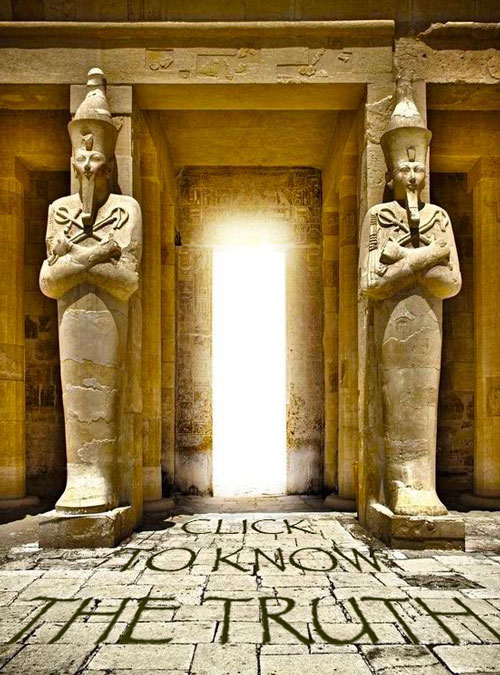The Yin Yang
In Chinese philosophy, there are two complementary yet opposing forces:

These powers may be used to describe a circle. Indeed, a circle uses π which mathematicians refer to as irrational and transcendental. But π really describes a ratio that is both dynamic and constant. In this sense it is also the union of fluidity and structure, asymmetry and symmetry, chaos and cosmos.
How else can we describe this paradox? Well, we can bend light. Optically, this is known as birefringence, where a single red dot can be seen as two when viewed through a calcite crystal. No surprises then, that the pineal gland is made up of calcite micro-crystals in a nod to consciousness itself. Self-awareness then, requires a mirror.

Once this transverse portal is opened, it allows the life force that we call aether to travel from the enfolded to the unfolded cosmos, or from unmanifest unconsciousness to manifest consciousness. It’s like opening a gate between worlds where awareness may enter. Here we are reminded again of the fractal properties of the human lungs and brain.
Perceived opposites also appear in the axes of the Mandelbrot set. The resulting pattern is symbolic of the human soul—harmonising real and imaginary, simplicity and complexity, motif and melody. This 2D set has a simple definition that gets more complicated when it is magnified. Animations of the Mandelbrot set exhibit an infinitely complicated boundary that reveals finer recursive detail at increasing magnifications. If we look at this in mathematical terms, the boundary of the Mandelbrot set is a fractal curve.

Fractals, including the Mandelbrot set, exhibit self-similarity and recursive patterns. The figure-eight symbol can be seen as a simple, continuous loop which may evoke the idea of endless repetition and self-similarity found in fractals. The infinity sign can be a visual representation of boundlessness, akin to the infinite complexity within fractals.
Indeed, consciousness can be attained by understanding this figure-eight pattern on an artistic level—peace and bliss start to blossom when our etheric fields are harmonised. So awareness is being fractal. One of the ways to do this is to surround ourselves with other fractals (rivers, snowflakes) or to practice movement that draws charge (yoga, tai chi). So consciousness itself has a dual quality that we associate with double refraction. This is the secret of rose granite and why every sacred Egyptian edifice was built with this stone.

Fractals are the geometry of eternity—they describe how life granted by our creator inspires more life in His own image. In a sense the Mandelbrot set reminds us of the paradox of the divided whole or mercury within cinnabar. When we are at peace that perceived opposites can be “one” and “both” at once then consciousness blooms.
The human soul can be seen as infinitely complex, with layers of thought, emotion and instinct that can be explored endlessly. Just like the Mandelbrot set, the deeper you delve into the psyche, the more you discover about yourself and the human condition. Indeed, our biology is fractal because our soul is fractal. Our soul is fractal because the aether is fractal. In humans, these octaves are harmonised within the recursive breath.

Above: the Winged Disc still inspires corporate logos around the world
The twin serpents emerging from the disc represent mercury. Hg embodies the qualities of rearing snakes in the name hydrargyrum or “water-silver”. Since mercury isn’t really a solid it lacks a crystal structure and technically isn’t a mineral but rather a mineraloid. Here we are reminded of the mercurial nature of the aether itself.
Embodying both the solid and liquid states, mercury reflects the polarity of the axes of the Mandelbrot set. With an atomic number of 80 it was often represented by a serpent. Mercury is the only metal for which the alchemical name remains the common name. In refined form, it resembles a mirror.

Above: cinnabar or mercury sulphide (HgS)
In the liquid crystal structure above the snakes are apparent. The primary mercury ore is cinnabar, which when heated readily decomposes leaving behind pure, metallic mercury which sinks to the bottom of the vessel. The richest mercury ores contain up to 2.5 per cent mercury by mass. Cinnabar occurs within volcanic veins and alkaline hot springs.

To produce liquid mercury, crushed cinnabar ore is roasted in rotary furnaces. Pure mercury separates from sulfur in this process and easily evaporates. A condensing column is used to collect the liquid metal, which is most often shipped in iron flasks.

Once mercury is purified, it can dissolve metals such as gold and silver to form amalgams. Iron is an exception, and iron flasks have traditionally been used to trade mercury. Alchemists (mystics) thought of mercury (aether) as the “First Matter” from which all metals (souls) were formed.
